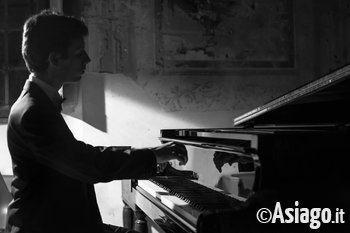Sunday 1/4/2018 at 21:00
Concerts

Music by Bach, Mozart, Chopin, Schubert
Artemusica Culture of Roana continues its activities by offering to fans on Easter traditional meeting with classical music, presenting a concert that will see the welcome return of an extraordinary young pianist, Thomas the Graiff, who will accompany the public to enjoy works by Bach, Mozart, Chopin, Schubert.
The evening will take place on Sunday 1 April, at 21.00, at the Council Chamber of the Town Hall of Canove, as always admission free, and will be followed by light refreshments.
Thomas the Graiff, after he began studying piano at an early age, he was trained in the class of Nicoletta Antoniacomi at the Conservatory F.A. Bonporti of Trento. After obtaining a high school diploma with full marks at Liceo Giovanni Prati in Trento, from autumn 2015 continues his studies with Alexander Meinel and Caspar Frantz at the Hochschule für Musik und Theater "Felix Mendelssohn-Bartholdy" in Leipzig.
To his training helped the masterclass of George Kern, Balázs Réti, Massimiliano Damerini and Pietro de Maria; Since 2013 he attended the Internationale Sommerakademie Mozarteum in Salzburg in classes of Olivier Gardon, Peter Lang, and Robert Levin, where he was selected to participate in the concerts of the students.
Awarded in national competitions the Graiff, Tommaso has performed in several European countries; the Repertoire of his active concert historical ranges from Bach to the 20th century, from Lieder to Chamber music. He recently collaborated with the Bach-Box-Ensemble Kammerschauspielerin actress Barbara Blümel, Director Martin Krumbiegel and the Chamber Choir VOX HUMANA Leipzig.
Notes about the program:
The fifth round of Bach was published in Leipzig in 1731 inside the Clavierübung, an imposing project by Bach with educational aims. The term Match indicates in this case a suite of dances: preceded by a virtuosic, Preamble, these take off with an Allemande smoothly and great proportions, continues with a sparkling Stream and self-possessed and, after pausing a meditative Sarabande in the behaviour and paren gallant minuet and Passepied, lead to great Gig, characterized by complex polyphonic invoice. This is the true pinnacle of composition of the match, in which Bach fuses the gallant element with the rigour of a full-blown getaway.
The Sonata K 332 dates back to the earliest years of Mozart's Vienna, a period of great success for the composer. The temporal proximity with early operatic masterpieces (Idomeneo, the abduction from the Seraglio) is evident in the first half, whose thematic material is attached by episodes of strong drama. The Adagio cantabile and expressive world of great introduces a poem; remarkable recovery richly embellished. The ending of an extensive formal conception, it is closely related to the piano concertos, which is assimilated by the instrumental brilliance and the mutability of mood.
Nocturnes op. 62 belong to the last production chopiniana and are characterized by a unique and expressive harmonic climate. The first night, after a theatrical gesture of openness, presents a lyrical and expansive initial part, while in the central section a long melody in the right hand is destabilized by constant syncopes on the left. The resumption of the first part, which flourished from long chains of trills, follows an ethereal and suspended queue. The second Nocturne alternating elements in stronger contrast: a long melody gives way in the middle section in a minor episode, in which the counterpoint is charged with painful accents. Significantly shortened recovery and a short tail comment and conclude the Nocturne.
The Ungarische melodies (Melody Hungarian) D 817 is the transcription of a song heard randomly by Schubert during a stay at the Esterházy Castle in Zseliz (Hungary) in 1824. The three Klavierstücke d. 946 date back to 1828, Schubert's death. The first piece alternates with a restless-with the character of a ride-two central sections of breath more lyrical. The second Klavierstück opens with a beautiful melody of intimacy typically Schubert's keyboard masterpieces; following two incidents in stark contrast: before a hectic scene and dreamlike, elegiac tone and then a section from melancholy. The triad is closed by a brilliant Allegro, whose central part is a Slavic dance from kaleidoscopic color variations.
All rights reserved.